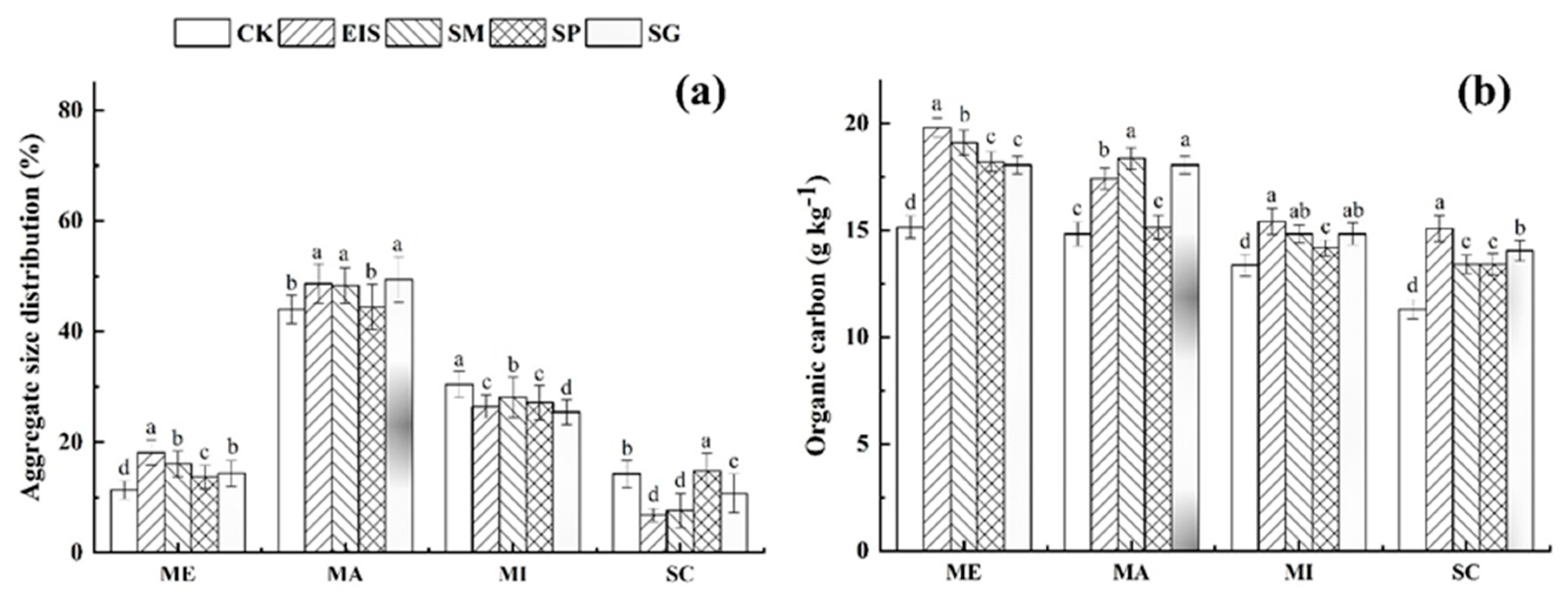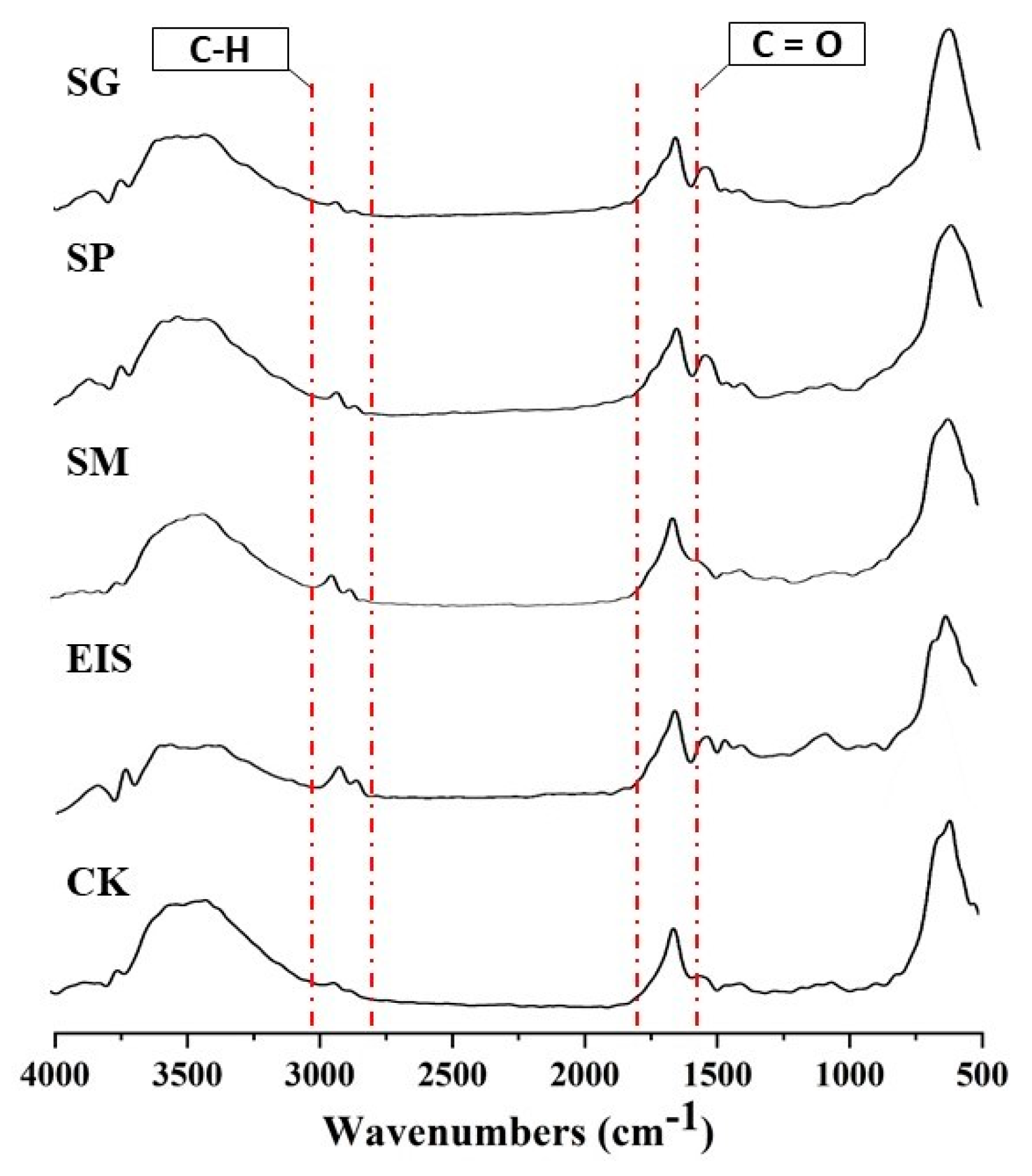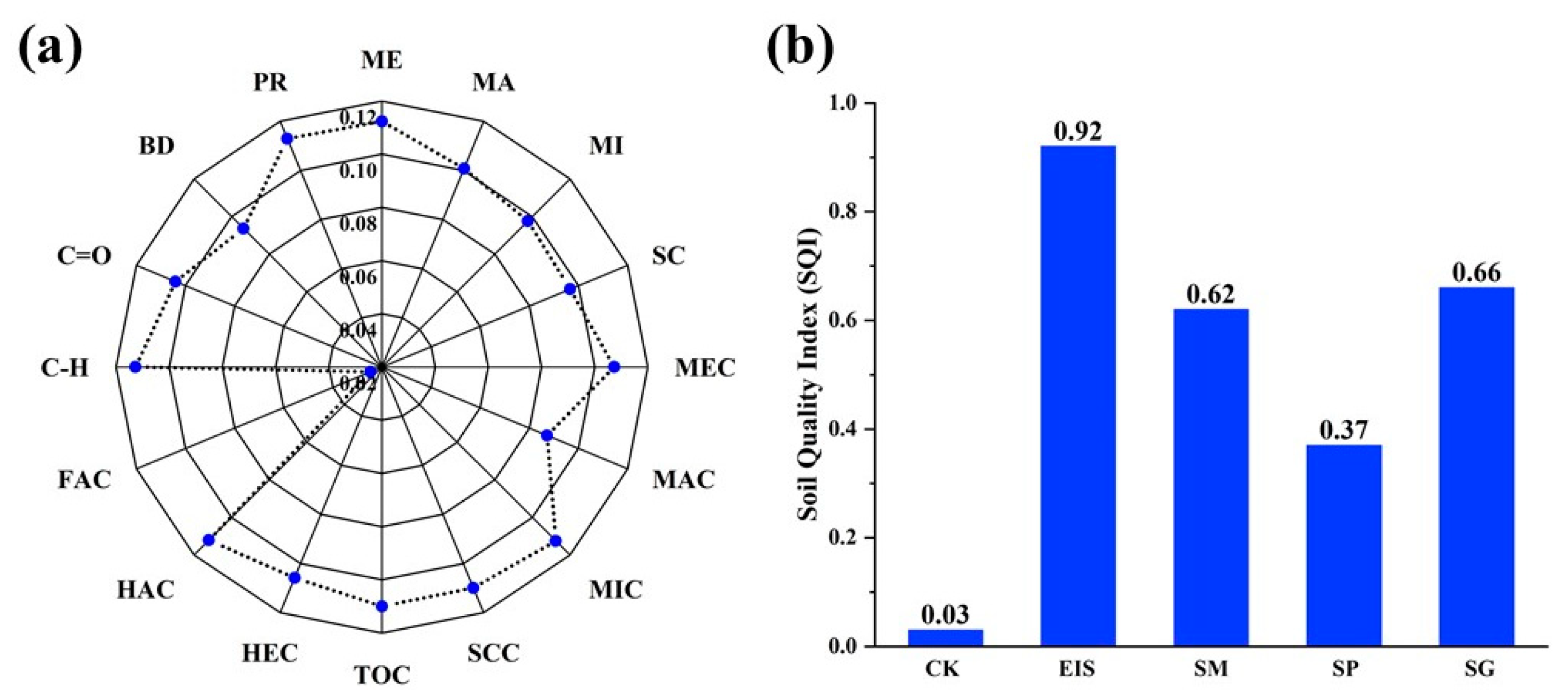Short-Term Effects of Different Straw Returning Methods on the Soil Physicochemical Properties and Quality Index in Dryland Farming in NE China
Abstract
1. Introduction
2. Materials and Methods
2.1. Experimental Site
2.2. Experimental Design
2.3. Soil Sampling and Lab Procedures
2.4. FTIR Measurements
2.5. Calculations
2.5.1. Mean Weight diameter and Geometric Mean Diameter
2.5.2. Soil Quality Index
2.6. Statistical Analysis
3. Results
3.1. Soil Bulk Density and Penetration Resistance
3.2. TOC and Humic C
3.3. Soil Aggregate Stability
3.4. Soil Aggregate-Associated Organic C
3.5. FTIR Spectra of Soil Samples
3.6. Soil Quality Index
4. Discussion
4.1. Effects of Straw Returning on Soil Structural Parameters
4.2. Effects of Straw Returning on TOC and Humic C
4.3. Effects of Straw Returning on Soil Aggregate Associated Organic C
4.4. Effects of Straw Returning on SOC Structural Characteristics
4.5. Effects of Soil Quality Index
5. Conclusions
Author Contributions
Funding
Acknowledgments
Conflicts of Interest
References
- Plaza, C.; Zaccone, C.; Sawicka, K.; Méndez, A.M.; Tarquis, A.; Gascó, G.; Heuvelink, G.B.M.; Schuur, E.A.G.; Maestre, F.T. Soil resources and element stocks in drylands to face global issues. Sci. Rep. 2018, 8, 13788. [Google Scholar] [CrossRef] [PubMed]
- Rakkar, M.K.; Blanco-Canqui, H. Grazing of crop residues: Impacts on soils and crop production. Agric. Ecosyst. Environ. 2018, 258, 71–90. [Google Scholar] [CrossRef]
- Bichel, A.; Oelbermann, M.; Echarte, L. Impact of residue addition on soil nitrogen dynamics in intercrop and sole crop agroecosystems. Geoderma 2017, 304, 12–18. [Google Scholar] [CrossRef]
- Chatterjee, S.; Bandyopadhyay, K.K.; Pradhan, S.; Singh, R.; Datta, S.P. Effects of irrigation, crop residue mulch and nitrogen management in maize (Zea mays L.) on soil carbon pools in a sandy loam soil of Indo-gangetic plain region. Catena 2018, 165, 207–216. [Google Scholar] [CrossRef]
- Choudhury, S.G.; Srivastava, S.; Singh, R.; Chaudhari, S.K.; Sharma, D.K.; Singh, S.K. Tillage and residue management effects on soil aggregation, organic carbon dynamics and yield attribute in rice-wheat cropping system under reclaimed sodic soil. Soil Tillage Res. 2014, 136, 76–83. [Google Scholar] [CrossRef]
- Wright, S.; Anderson, R. Aggregate stability and glomalin in alternative crop rotations for the central Great Plains. Biol. Fertil. Soils. 2000, 31, 249–253. [Google Scholar] [CrossRef]
- Dai, X.; Li, Y.; Zhu, O.; Wang, H.; Wilson, G.V. Organic manure as an alternative to crop residues for no-tillage wheat–maize systems in North China Plain. Field Crops Res. 2013, 149, 141–148. [Google Scholar] [CrossRef]
- Fan, W.; Wu, J.; Li, J.; Hu, J. Comparative effects of different maize straw returning modes on soil humus composition and humic acid structural characteristics in Northeast China. Chem. Ecol. 2018, 34, 355–370. [Google Scholar] [CrossRef]
- Haumaier, L.; Zech, W. Black carbon—possible source of highly aromatic components of soil humic acids. Org. Geochem. 1995, 23, 191–196. [Google Scholar] [CrossRef]
- Cui, T.; Li, Z.; Wang, S. Effects of in-situ straw decomposition on composition of humus and structure of humic acid at different soil depths. J. Soil. Sediment. 2017, 17, 2391–2399. [Google Scholar] [CrossRef]
- O’Brien, S.L.; Jastrow, J.D. Physical and chemical protection in hierarchical soil aggregates regulates soil carbon and nitrogen recovery in restored perennial grasslands. Soil Bio Biochem. 2013, 61, 1–13. [Google Scholar] [CrossRef]
- Hu, J.; Wu, J.; Qu, X. Decomposition characteristics of organic materials and their effects on labile and recalcitrant organic carbon fractions in a semi-arid soil under plastic mulch and drip irrigation. J. Arid Land. 2018, 10, 115–128. [Google Scholar] [CrossRef]
- Zheng, H.; Ouyang, Z.Y.; Wang, X.K.; Miao, H.; Zhao, T.Q.; Peng, T.B. How different reforestation approaches affect red soil properties in southern China. Land Degrad. Dev. 2005, 16, 387–396. [Google Scholar] [CrossRef]
- Xu, X.L.; Ma, K.M.; Fu, B.J.; Liu, W.; Song, C.J. Soil and water erosion under different plant species in a semiarid river valley, SW China: The effects of plant morphology. Ecol. Res. 2009, 24, 37–46. [Google Scholar] [CrossRef]
- Li, R.; Kan, S.; Zhu, M.; Chen, J.; Ai, X.; Chen, Z.; Ai, Y. Effect of different vegetation restoration types on fundamental parameters, structural characteristics and the soil quality index of artificial soil. Soil Tillage Res. 2018, 184, 11–23. [Google Scholar] [CrossRef]
- Zhao, H.; Shar, A.G.; Li, S.; Chen, Y.; Shi, J.; Zhang, X.; Tian, X. Effect of straw return mode on soil aggregation and aggregate carbon content in an annual maize-wheat double cropping system. Soil Tillage Res. 2018, 175, 178–186. [Google Scholar] [CrossRef]
- Tisdall, J.M.; Oades, J.M. Organic matter and water-stable aggregates in soils. J. Soil Sci. 1982, 33, 141–163. [Google Scholar] [CrossRef]
- Amezketa, E. Soil aggregate stability: A review. J. Sustain. Agric. 1999, 14, 83–151. [Google Scholar] [CrossRef]
- Pucciariello, R.; Villani, V.; Bonini, C.; D’Auria, M.; Vetere, T. Physical properties of straw lignin-based polymer blends. Polymer 2004, 45, 4159–4169. [Google Scholar] [CrossRef]
- Del Río, J.C.; Rencoret, J.; Prinsen, P.; Martínez, A.T.; Ralph, J.; Gutiérrez, A. Structural characterization of wheat straw lignin as revealed by analytical pyrolysis, 2D-NMR, and reductive cleavage methods. J. Agric. Food Chem. 2012, 60, 5922–5935. [Google Scholar] [CrossRef]
- Akhtar, K.; Wang, W.; Ren, G.; Khan, A.; Feng, Y.; Yang, G. Changes in soil enzymes, soil properties, and maize crop productivity under wheat straw mulching in Guanzhong, China. Soil Tillage Res. 2018, 182, 94–102. [Google Scholar] [CrossRef]
- Kabir, Z. Tillage or no-tillage: Impact on mycorrhizae. Can. J. Plant. Sci. 2005, 85, 23–29. [Google Scholar] [CrossRef]
- Liu, C.; Lu, M.; Cui, J.; Li, B.; Fang, C. Effects of straw carbon input on carbon dynamics in agricultural soils: A meta-analysis. Glob Chang. Biol. 2014, 20, 1366–1381. [Google Scholar] [CrossRef] [PubMed]
- Hao, M.; Hu, H.; Liu, Z.; Dong, Q.; Sun, K.; Feng, Y.; Ning, T. Shifts in microbial community and carbon sequestration in farmland soil under long-term conservation tillage and straw returning. Appl. Soil Ecol. 2019, 136, 43–54. [Google Scholar] [CrossRef]
- Santos, V.B.; Araújo, A.S.; Leite, L.F.; Nunes, L.A.; Melo, W.J. Soil microbial biomass and organic matter fractions during transition from conventional to organic farming systems. Geoderma 2012, 170, 227–231. [Google Scholar] [CrossRef]
- Song, G.X.; Novotny, E.H.; Mao, J.D.; Hayes, M.H.B. Characterization of transformations of maize residues into soil organic matter. Sci. Total Environ. 2017, 579, 1843–1854. [Google Scholar] [CrossRef]
- Ingelmo, F.; Molina, M.J.; Soriano, M.D.; Gallardo, A.; Lapeña, L. Influence of organic matter transformations on the bioavailability of heavy metals in a sludge based compost. J. Environ. Manag. 2012, 95, S104–S109. [Google Scholar] [CrossRef]
- Slepetiene, A.; Slepetys, J. Status of humus in soil under various long-term tillage systems. Geoderma 2005, 127, 207–215. [Google Scholar] [CrossRef]
- Tao, Z.; Li, C.; Li, J.; Ding, Z.; Xu, J.; Sun, X.; Zhou, P.; Zhao, M. Tillage and straw mulching impacts on grain yield and water use efficiency of spring maize in Northern Huang–Huai–Hai Valley. Crop J. 2015, 3, 445–450. [Google Scholar] [CrossRef]
- Chen, W.; Westerhoff, P.; Leenheer, J.A.; Booksh, K. Fluorescence excitation-emission matrix regional integration to quantify spectra for dissolved organic matter. Environ. Sci. Technol. 2003, 37, 5701–5710. [Google Scholar] [CrossRef]
- Huang, T.; Yang, H.; Huang, C.; Ju, X. Effects of nitrogen management and straw return on soil organic carbon sequestration and aggregate-associated carbon. Eur. J. Soil Sci. 2018, 69, 913–923. [Google Scholar] [CrossRef]
- Liu, S.; Yan, C.; He, W.; Chen, B.; Zhang, Y.; Liu, Q.; Liu, E. Effects of different tillage practices on soil water-stable aggregation and organic carbon distribution in dryland farming in Northern China. Acta Ecol. Sin. 2015, 35, 65–69. [Google Scholar] [CrossRef]
- Zaccone, C.; Beneduce, L.; Lotti, C.; Martino, G.; Plaza, C. DNA occurrence in organic matter fractions isolated from amended, agricultural soils. Appl. Soil Ecol. 2018, 130, 134–142. [Google Scholar] [CrossRef]
- Zhang, J.J.; Hu, F.; Li, H.; Gao, Q.; Song, X.; Ke, X.; Wang, L. Effects of earthworm activity on humus composition and humic acid characteristics of soil in a maize residue amended rice-wheat rotation agroecosystem. Appl. Soil Ecol. 2011, 51, 1–8. [Google Scholar] [CrossRef]
- Rennert, T.; Ghong, N.P.; Rinklebe, J. Permanganate-oxidizable soil organic matter in floodplain soils. Catena 2017, 149, 381–384. [Google Scholar] [CrossRef]
- Zhou, T.; Wu, L.; Luo, Y.; Christie, P. Effects of organic matter fraction and compositional changes on distribution of cadmium and zinc in long-term polluted paddy soils. Environ. Pollut. 2018, 232, 514–522. [Google Scholar] [CrossRef]
- Demyan, M.S.; Rasche, F.; Schulz, E.; Breulmann, M.; Müller, T.; Cadisch, G. Use of specific peaks obtained by diffuse reflectance Fourier transform mid-infrared spectroscopy to study the composition of organic matter in a Haplic Chernozem. Eur. J. Soil Sci. 2012, 63, 189–199. [Google Scholar] [CrossRef]



| Treatment | BD (g cm−3) | PR (MPa) |
|---|---|---|
| CK | 1.41 ± 0.04a | 0.73 ± 0.06a |
| EIS | 1.02 ± 0.04c | 0.51 ± 0.09b |
| SM | 1.38 ± 0.06a | 0.59 ± 0.05ab |
| SP | 1.33 ± 0.05a | 0.65 ± 0.09ab |
| SG | 1.23 ± 0.02b | 0.63 ± 0.09ab |
| Treatment | TOC | HEC | HAC | FAC | HAC/FAC | Δ Log K (HA) |
|---|---|---|---|---|---|---|
| CK | 14.98 ± 0.06d | 5.88 ± 0.22d | 3.37 ± 0.26d | 2.51 ± 0.31b | 1.34 | 0.48 |
| EIS | 20.58 ± 0.58a | 8.48 ± 0.09a | 5.93 ± 0.12a | 2.55 ± 0.13a | 2.39 | 0.59 |
| SM | 17.97 ± 0.12c | 7.45 ± 0.05c | 5.23 ± 0.26bc | 2.22 ± 0.19b | 2.35 | 0.53 |
| SP | 17.98 ± 0.06c | 7.92 ± 0.16b | 4.90 ± 0.27c | 3.02 ± 0.32a | 1.62 | 0.50 |
| SG | 19.84 ± 0.13b | 7.81 ± 0.14b | 5.48 ± 0.10b | 2.33 ± 0.09b | 2.35 | 0.43 |
| Treatment | MWD (mm) | GMD (mm) |
|---|---|---|
| CK | 0.78 ± 0.02b | 0.42 ± 0.07b |
| EIS | 0.95 ± 0.03a | 0.59 ± 0.05a |
| SM | 0.91 ± 0.06a | 0.55 ± 0.01a |
| SP | 0.82 ± 0.03b | 0.40 ± 0.04b |
| SG | 0.89 ± 0.01a | 0.53 ± 0.08a |
| Treatment | Relative Intensity (%) | Hydrophobicity Index | |
|---|---|---|---|
| C-H | C = O | C-H/C = O | |
| CK | 0.828 | 7.294 | 0.114 |
| EIS | 2.106 | 4.326 | 0.487 |
| SM | 1.549 | 5.520 | 0.281 |
| SP | 1.283 | 7.299 | 0.176 |
| SG | 1.401 | 5.028 | 0.279 |
| SG | 0.407 | 7.653 | 0.053 |
| Principal components | PC1 | PC2 |
|---|---|---|
| Eigenvalue | 13.07 | 2.41 |
| Percent | 81.69% | 15.06% |
| Eigenvectors | Loading values | |
| Soil bulk density (BD) | –0.229 | –0.221 |
| Penetration resistance (PR) | –0.276 | 0.022 |
| Mega-aggregate content (ME) | 0.274 | –0.071 |
| Macroaggregate content (MA) | 0.246 | –0.291 |
| Microaggregate content (MI) | –0.238 | –0.267 |
| Silt and clay content (SC) | –0.236 | 0.321 |
| Mega-aggregate associated organic carbon (MEC) | 0.262 | 0.011 |
| Macroaggregate associated organic carbon (MAC) | 0.213 | –0.396 |
| Microaggregate associated organic carbon (MIC) | 0.275 | –0.054 |
| Silt and clay associated organic carbon (SCC) | 0.268 | 0.142 |
| Soil organic carbon (SOC) | 0.269 | 0.145 |
| Humic fraction carbon (HEC) | 0.258 | 0.226 |
| Humic acid carbon (HAC) | 0.274 | 0.081 |
| Fulvic acid carbon (FAC) | 0.060 | 0.627 |
| Relative intensity of C-H bonds (C-H) | 0.275 | 0.018 |
| Relative intensity of C = O bonds (C = O) | –0.254 | 0.179 |
© 2020 by the authors. Licensee MDPI, Basel, Switzerland. This article is an open access article distributed under the terms and conditions of the Creative Commons Attribution (CC BY) license (http://creativecommons.org/licenses/by/4.0/).
Share and Cite
Fan, W.; Wu, J.; Ahmed, S.; Hu, J.; Chen, X.; Li, X.; Zhu, W.; Opoku-Kwanowaa, Y. Short-Term Effects of Different Straw Returning Methods on the Soil Physicochemical Properties and Quality Index in Dryland Farming in NE China. Sustainability 2020, 12, 2631. https://doi.org/10.3390/su12072631
Fan W, Wu J, Ahmed S, Hu J, Chen X, Li X, Zhu W, Opoku-Kwanowaa Y. Short-Term Effects of Different Straw Returning Methods on the Soil Physicochemical Properties and Quality Index in Dryland Farming in NE China. Sustainability. 2020; 12(7):2631. https://doi.org/10.3390/su12072631
Chicago/Turabian StyleFan, Wei, Jinggui Wu, Sharaf Ahmed, Juan Hu, Xiaodong Chen, Xiaohang Li, Wenyue Zhu, and Yaa Opoku-Kwanowaa. 2020. "Short-Term Effects of Different Straw Returning Methods on the Soil Physicochemical Properties and Quality Index in Dryland Farming in NE China" Sustainability 12, no. 7: 2631. https://doi.org/10.3390/su12072631
APA StyleFan, W., Wu, J., Ahmed, S., Hu, J., Chen, X., Li, X., Zhu, W., & Opoku-Kwanowaa, Y. (2020). Short-Term Effects of Different Straw Returning Methods on the Soil Physicochemical Properties and Quality Index in Dryland Farming in NE China. Sustainability, 12(7), 2631. https://doi.org/10.3390/su12072631





